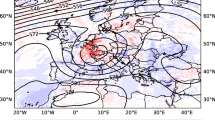Abstract
There has been extensive research on the problem of stochastically generating daily rainfall sequences for use in water management applications. Srikanthan and McMahon [Australia Water Resources Council, Canberra, 1985] proposed a transition probability matrix (TPM) model that performs better for Australian rainfall than many alternative models, particularly where long records (say 100 years) are available. Boughton [Report 99/9, CRC for Catchment Hydrology, Monash University, Melbourne, 21pp, 1999] incorporated an empirical adjustment into the TPM model that allows the model to reproduce the observed variability in the annual rainfall. More recently, Harrold et al. [Water Resour Res 39(10, 12):1300, 1343, 2003a,b] proposed nonparametric models for the generation of daily rainfall occurrences and rainfall amounts on wet days. By conditioning on short, medium and long-term characteristics, this approach is also able to preserve the variability in annual rainfall. In this study, the above two approaches were used to generate daily rainfall data for Sydney and Melbourne, and the results evaluated. Both approaches preserved most of the daily, monthly and annual characteristics that were compared, with the nonparametric approach providing marginally better performance at the cost of greater model complexity. The nonparametric approach was also able to preserve the variability and persistence in the annual number of wet days.









Similar content being viewed by others
References
Boughton WC (1999) A daily rainfall generating model for water yield and flood studies. Report 99/9, CRC for Catchment Hydrology, Monash University, Melbourne, p 21
Buishand TA (1978) Some remarks on the use of daily rainfall models. J Hydrol 36:295–308
Chapman TG (1994) Stochastic models for daily rainfall. Water Down Under 94. Institution of Engineers Australia 3:7–12
Chapman TG (1998) Stochastic modelling of daily rainfall: the impact of adjoining wet days on the distribution of rainfall amounts. Environ Model Softw 13:317–324
Chapman TG (2001)Refinements to the Srikanthan-McMahon stochastic model for daily rainfall. MODSIM 2001 Int Cong Model Simul 1:287–292
Gabriel KR, Neumann J (1962) A Markov chain model for daily rainfall occurrence at Tel Aviv. Q J R Meteorol Soc 88:90–95
Haan CT, Allen DM, Street JD (1976) A Markov chain model of daily rainfall. Water Resour Res 12(3):443–449
Harrold TI, Sharma A, Sheather SJ (2003a) A nonparametric model for stochastic generation of daily rainfall occurrence. Water Resour Res 39(10):1300, doi:10.1029/2003WR002182
Harrold TI, Sharma A, Sheather SJ (2003b) A nonparametric model for stochastic generation of daily rainfall amounts. Water Resour Res 39(12):1343, doi:10.1029/2003WR002570
Lall U, Rajagopalan B, Tarboton DG (1996) A nonparametric wet/dry spell model for resampling daily precipitation. Water Resour Res 32(9):2803–2823
Rajagopalan B, Lall U, Tarboton DG (1996) Nonhomogeneous Markov model for daily precipitation. J Hydro Eng 1(1):33–40
Sharma A, Lall U (1999) A nonparametric approach to daily rainfall simulation. Math Compu Simul 48:367–371
Sharma A, O’Neill R (2002) A nonparametric approach for representing interannual dependence in monthly streamflow sequences. Water Resour Res 138(7):5–1:5–10
Sharma A, Tarboton DG, Lall U (1997) Streamflow simulation: a nonparametric approach. Water Resour Res 33(2):291–308
Silverman BW (1986) Density estimation for statistics and data analysis. Chapman & Hall, New York
Srikanthan R, McMahon TA (1985) Stochastic generation of rainfall and evaporation data, Technical Paper No. 84. Australia Water Resources Council, Canberra
Srikanthan R, McMahon TA (2001) Stochastic generation of annual, monthly and daily climate data: a review. Hydrol Earth Sys Sci 5(4):653–656
Woolhiser DA (1992) Modeling daily precipitation—progress and problems. In: Walden AT, Guttorp P (eds) Statistics in the environmental and earth sciences. Edward Arnold, London, p 306
Zhou SL, Srikanthan R, McMahon TA, Wang QJ, Nathan R (2002) Stochastic modeling of daily rainfall. Hydrology and Water Resources Symposium, Institution of Engineers, Australia
Acknowledgements
We thank Tom Chapman and an anonymous reviewer, who provided helpful comments on the paper. The second author would like to acknowledge the support of the Japan Society for the Promotion of Science for helping to fund this work.
Author information
Authors and Affiliations
Corresponding author
Rights and permissions
About this article
Cite this article
Srikanthan, R., Harrold, T.I., Sharma, A. et al. Comparison of two approaches for generation of daily rainfall data. Stoch Environ Res Ris Assess 19, 215–226 (2005). https://doi.org/10.1007/s00477-004-0226-0
Published:
Issue Date:
DOI: https://doi.org/10.1007/s00477-004-0226-0




